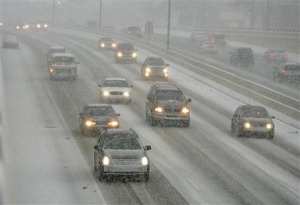
Driving
in unpleasant weather is no picnic, whether it's simply to the grocer's
or across different states. That's why it pays to have a well-prepared
car. Seeing to it that the vehicle is ready for whatever climets show up
and not rushing to get to a destination will ensure that you and your
vehicle arrive safe and in one piece.
Traveling Safe in Winter
The
AAA and Department of Transportation offer several tips to make winter
travels safer. See to it that the following are taken care of:
 Car Care Essentials:
Car Care Essentials:
1. Always have the gas tank half-full. This prevents moisture from accumulating and becoming frozen in the gas tubes or lines.
2. Check the battery connections. They have to be clean and secure. Batteries older than three years should be replaced.
3. Make a safety kit for winter. It's a box containing spare batteries;
a
flashlight; one sleeping bag or blanket; extra hats, rain gear, socks
and
gloves; one sack of non-clumpy kitty litter or sand for traction in
case you are trapped in snow; jumper cables; a big bright-colored cloth
to serve as flag; bottled water; non-perishable foods, one small kit
for tools; and a first-aid kit.
4. Check the car. See that the windshield wiper fluid and anti-freeze are enough.
5. Make sure tires are inflated properly and frequently. Icy
temperatures can cause the tire air pressure to drop, affecting handling
and traction.
6. Clean lights and mirrors. See that the lights are all aimed right.
Pre-departure reminders:
1. See
to it that all roads included in your trip route are open and passable.
The US Department of Transportation Federal Highway Administration
website www.fhwa.dot.gov/trafficinfo provides updates to keep you
posted.
2. Warm up the vehicle in open areas. The garage and other enclosed parking places aren't the best for warming up cars.
3. When taking trips or passing through remote locations, inform
friends or family where you plan to be. Let them in on the route to be
taken and estimated arrival time.
The actual trip heads-up:
1. Keep headlights turned on.
2. Raise stopping distances between the vehicle ahead and you.
3. Be on the lookout for drivers who could be having issues with roadway conditions.
4. If feeling uncomfortable about driving, find a secure place and park there for a while.
5. Always buckle up.
6. Slow down, please. Gradual acceleration and deceleration is best. Refrain from frequent use of the cruise control.
7. Never pass other cars on or when close to bridges.
Keep all these
safety measures and
you're sure to arrive at your destination with everything intact. They
can spell the difference between a great trip and an unfortunate,
regrettable, mishap-ridden outing.
DontGetHit.com


0 Comments:
Post a Comment
Subscribe to Post Comments [Atom]